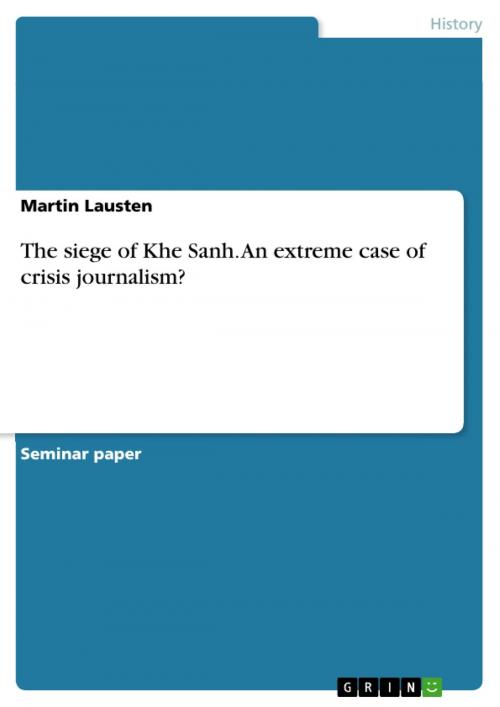The siege of Khe Sanh. An extreme case of crisis journalism?
Nonfiction, History, Americas, United States| Author: | Martin Lausten | ISBN: | 9783668235021 |
| Publisher: | GRIN Publishing | Publication: | June 7, 2016 |
| Imprint: | GRIN Publishing | Language: | English |
| Author: | Martin Lausten |
| ISBN: | 9783668235021 |
| Publisher: | GRIN Publishing |
| Publication: | June 7, 2016 |
| Imprint: | GRIN Publishing |
| Language: | English |
Seminar paper from the year 2015 in the subject History - America, grade: A-, Aalborg University, course: USA in the 60's, language: English, abstract: This paper will address the topic of how and why the American news media reported and interpreted the Tet Offensive and the Siege of Khe Sanh during the Vietnam War the way they did. In order to answer this question I have divided the paper up into two chapters; both chapters will follow a chronological analysis and fact presentation form. The first chapter will deal with the military reality of the Tet Offensive and the Siege of Khe Sanh; the background to the Tet crisis, the day to day events and the ebb and flow of the siege etc. This chapter will serve as a background to chapter two, which will deal with the news media. Here I will examine and explain the performance of America's major press and television organizations who operated under conditions of unusual stress, complexity and uncertainty which prevailed in Vietnam and Washington during the Tet crisis. The surprise and ferociousness of the Offensive caught the American and South Vietnamese forces completely off-guard, and at home it came as a horrible shock both to the public and official Washington. Immediately the American public turned its attention towards Vietnam and in particular the besieged Marine compound at Khe Sanh. The importance of Khe Sanh was not just perceived by the U.S. military but also by the news media. During the Tet Offensive it would see more media coverage than any other place in Vietnam. It was the most fought over objective during the Tet offensive and after the siege ended both sides would claim victory. The U.S. Commander of all American forces in Vietnam William C. Westmoreland claimed that the Communists at Khe Sanh had tried to recreate their victory over the French at Dien Bien Phu in 1954. While the North Vietnamese commander General Giap stated that the siege was a diversion, meant to draw American troops to the Khe Sanh area and thus deplete the rest of South Vietnam of forces, in preparation for the Tet Offensive. However, there was a third part who played a role in the Tet Offensive and Siege of Khe Sanh, namely the American news media. The sudden penetration of downtown Saigon by Viet Cong sapper teams impacted personally on correspondents' lives. And daily, reporters in the field vividly brought the conflict home to the American people. The Siege of Khe Sanh was one of the best stories during the entire war; it filled a journalistic need that was exploited to the outmost.
Seminar paper from the year 2015 in the subject History - America, grade: A-, Aalborg University, course: USA in the 60's, language: English, abstract: This paper will address the topic of how and why the American news media reported and interpreted the Tet Offensive and the Siege of Khe Sanh during the Vietnam War the way they did. In order to answer this question I have divided the paper up into two chapters; both chapters will follow a chronological analysis and fact presentation form. The first chapter will deal with the military reality of the Tet Offensive and the Siege of Khe Sanh; the background to the Tet crisis, the day to day events and the ebb and flow of the siege etc. This chapter will serve as a background to chapter two, which will deal with the news media. Here I will examine and explain the performance of America's major press and television organizations who operated under conditions of unusual stress, complexity and uncertainty which prevailed in Vietnam and Washington during the Tet crisis. The surprise and ferociousness of the Offensive caught the American and South Vietnamese forces completely off-guard, and at home it came as a horrible shock both to the public and official Washington. Immediately the American public turned its attention towards Vietnam and in particular the besieged Marine compound at Khe Sanh. The importance of Khe Sanh was not just perceived by the U.S. military but also by the news media. During the Tet Offensive it would see more media coverage than any other place in Vietnam. It was the most fought over objective during the Tet offensive and after the siege ended both sides would claim victory. The U.S. Commander of all American forces in Vietnam William C. Westmoreland claimed that the Communists at Khe Sanh had tried to recreate their victory over the French at Dien Bien Phu in 1954. While the North Vietnamese commander General Giap stated that the siege was a diversion, meant to draw American troops to the Khe Sanh area and thus deplete the rest of South Vietnam of forces, in preparation for the Tet Offensive. However, there was a third part who played a role in the Tet Offensive and Siege of Khe Sanh, namely the American news media. The sudden penetration of downtown Saigon by Viet Cong sapper teams impacted personally on correspondents' lives. And daily, reporters in the field vividly brought the conflict home to the American people. The Siege of Khe Sanh was one of the best stories during the entire war; it filled a journalistic need that was exploited to the outmost.















